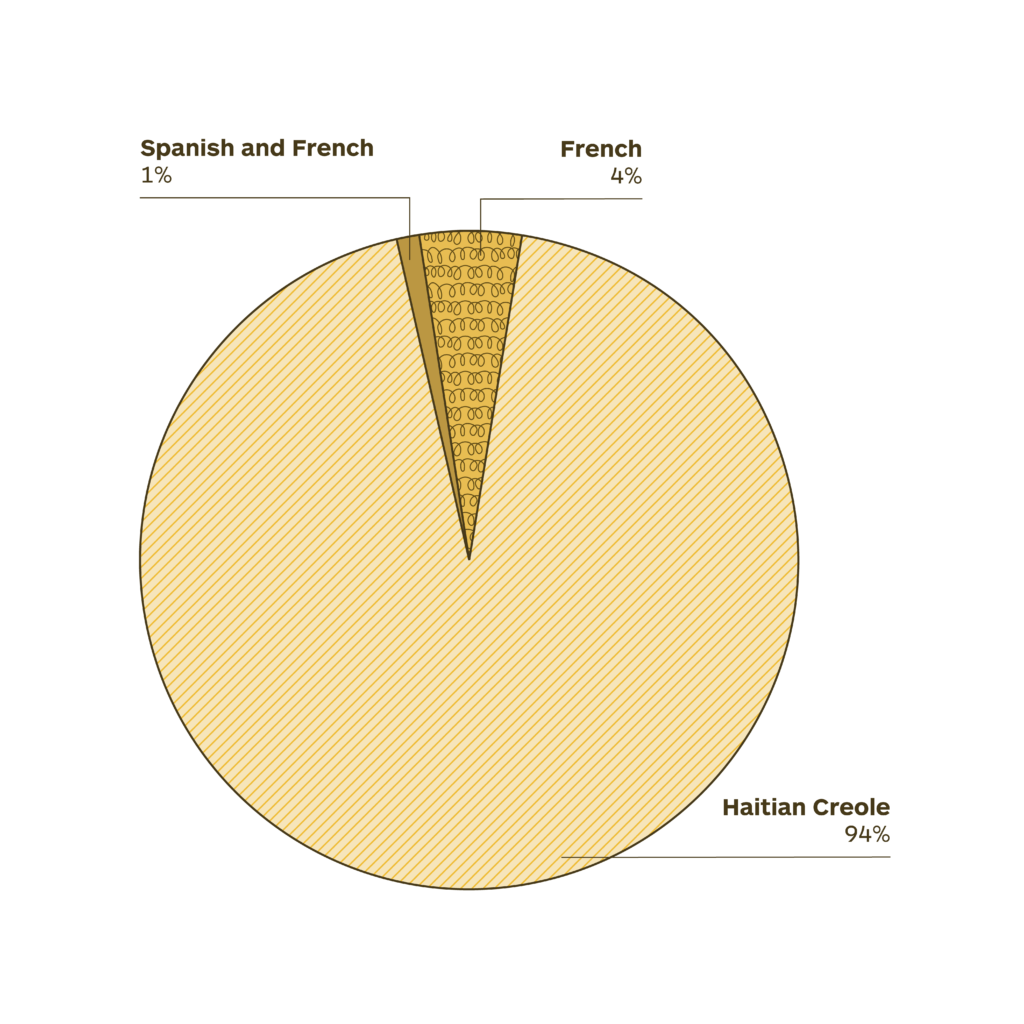North America
To which language should you translate to localize in Haiti?
What the 150 top websites do
Of the top 150 website (Global by design ranking):
- 36/150 translate into English.
- 13/150 translate into French.
- 7/150 translate into Spanish.
- 3/150 translate into Haitian Creole.
If you need others information, below you can find a selection of economic/social/cultural data
Overview
Language
Official language
French is the standard written language in Haiti. Despite French being the administrative language in Haiti, only 5% of Haitians are fluent in the language.
T-index
0.019%
T-Index ranks countries according to their potential for online sales.
Actual languages
Haitian Creole (94%), Spanish and English (1%).
English
Very low proficiency (EF) – 98 of 113 countries/regions in the world- 20/20 position in Latin America.
Demography
Capital: Port-au-Prince
Currency: Haitian gourde
Population: 11.58 m
Population density: 415/km2
Economy
GDP: 20.25 billion USD (2022)
GDP per capita: 1,748.3 USD (2022)
Exports: $1.28 billion (2020)
Statistics
Internet users: 38.9% penetration, 4.59 million
Unemployment rate: 14.1%
Urbanisation: 59% (2022)
Literacy: 62% (2016)
Conventions
Numbering system
Arabic numerals with dot as decimal separator.
Date format: yyyy-mm-dd / dd-mm-yyyy
Time: 24h time system
Country code: 00509
Language data sources: Worldatlas/Britannica//EF/Wikipedia; Demography data sources: IMF/Worldometers; Conventions data source: Wikipedia; Economy data sources: WTO/OEC/CIA/Esomar/Datareportal; Statistics data sources: Datareportal/WorldBank/UN/UNESCO/CEIC/IMF/Culturalatlas/Commisceoglobal
Facts and data
Economy
Imports
$3.9 billion (2022). Refined Petroleum ($525M), Rice ($256M), Other Cotton Fabrics ($142M), Light Rubberized Knitted Fabric ($133M), and Palm Oil ($126M), importing mostly from United States ($1.2B), Dominican Republic ($1.02B), China ($625M), Indonesia ($111M), and India ($92.6M).
In 2022, Haiti was the world’s biggest importer of Other Cotton Fabrics ($142M).
Financial inclusion factors (over 15 years of age)
• 28.2% have an account with a financial institution
• 6.9% have a credit card
• 13.5% have a mobile money account
Ease of doing business
Ease of conducting business is low (rated 40.7 out of 100). Ranked 31st out of 32 Latin American and Caribbean countries. Ranked 179th out of 190 countries worldwide (2023, World Bank).
Exports
$1.28 billion (2022). Knit T-shirts ($529M), Knit Sweaters ($220M), Knit Women’s Suits ($107M), Non-Knit Men’s Suits ($66.2M), and Non-Knit Men’s Shirts ($43.3M), exporting mostly to United States ($1.08B), Canada ($51M), Mexico ($29.4M), Thailand ($16.4M), and France ($15.9M).
Economic freedom
‘Mostly not free’ (rated 48.2 out of 100). Ranked 28th out of 32 Latin American countries. Ranked 155th out of 186 countries worldwide (2024, Heritage Foundation and Wall Street Journal).
Economy data sources: WTO/OEC/CIA/Esomar/Datareportal
Service Imports (2019)
Service Exports (2019)
Source: OEC
Trade balance of goods from 2012 to 2022
Source: Statista
Historical Data Trade Imports
The following section uses historical trade data imports from partners of Haiti.
Historical Data Trade Exports
The following section uses historical trade data exports from partners of Haiti.
Source: OEC
The Top Export Opportunities for Haiti by Relatedness
Relatedness measures the distance between a country's current exports and each product by showing only products that Haiti is not specialized in.
Haiti's Most Complex Exports
The Product Complexity Index (PCI) measures the knowledge intensity of a product by considering the knowledge intensity of its exporters.
Source: OEC
Haiti's Most Specialized Products
Specialization is measured using Revealed Comparative Advantage (RCA), an index that takes the ratio between Haiti observed and expected exports in each product.
Source: OEC
Market Growth Imports (2019)
This score represents the likelihood that the given country will start importing that product in the next few years. It forecasts the opening of a new specific market.
Market Growth Exports (2019)
This score represents the likelihood that the given country will start exporting that product in the next few years. It forecasts the opening of a new specific market.
Source: OEC
Foreign direct investment, net inflows (% of GDP)
Source: WorldBank

T-index
Reach most of the online purchasing power
T-Index ranks countries according to their potential for online sales. It estimates the market share of each country in relation to global e-commerce.
Try it nowMedia
Media language
French
Information channels
Radio is Haiti’s key news medium. The sector is crowded, with hundreds of stations. Most of them are local, privately-owned and broadcast in Creole. Audiences for the dozens of TV stations are limited by the lack of reliable power. Most TV stations have limited capacity to produce their own programmes. Newspaper circulations are small and are impeded by affordability and low literacy. However, newspaper websites are popular among Haitians abroad. The media reflect a range of views, but the work of journalists is hampered by threats, violence and government interference, says Freedom House. Reporters Without Borders (RSF) says the output of privately-owned media is strongly influenced by their owners. RSF says journalists “suffer a cruel lack of financial resources”.
The press
Le Nouvelliste – private daily
Haiti Progres – weekly
Television
Tele Caraibes – private
Radio Tele Ginen (RTG) – private
Tele Metropole – private
Television Nationale d’Haiti – government-owned
Radio
Radio Metropole – private
Radio Ginen -private
Radio Signal FM – private
Radio Caraibes FM – private
Radio Kiskeya – private
Radio Lumiere – Protestant
Radio Vision 2000 – private
News agency
Agence Haitienne de Presse
Haiti Libre – news site
Media data source: BBC
Internet Data
Internet users
38.9% penetration, 4.59 million
Share of web traffic by device
85.72% mobile phones, 11.60% computers (laptops and desktops), 2.68% tablet devices.
Median speed of mobile Internet connection
8.43 Mbps
Median speed of fixed Internet connection
32.36 Mbps
Mobile connection as a percentage of total population: 82.7%
Percentage of mobile connections that are broadband (3G-5G): 85%
Most popular web search engines
Google (98.45%), Bing (1.22%), Yahoo! (0.28%), DuckduckGo (0.02%), Ecosia (0.01%), other (0.02%).
Most used social media
Facebook (83.93%), Twitter (8.48%), Instagram (3.73%), Pinterest (2.35%), YouTube (1.41%), Tumblr (0.04%), LinkedIn (0.04%), other (0.02%).
Internet data sources: Datareportal/Statcounter
Social statistics
Life expectancy
63 yrs (2021)
Gender
Haitian culture is traditionally male-dominated. Men and women in Haiti in general have traditional gender roles. In rural areas, women are responsible for child rearing, cooking, cleaning and going to the market to either buy or sell goods. Men spend most of their time working the family farm. Normally, men will be the leaders in the community and women still tend to be submissive to their husbands.
Class
The class system in Haiti is derived from one’s wealth and income, one’s occupation and level of education. In addition, social status is a key factor. Who you know, particularly senior members of government and politicians, is important. Haiti’s upper class is made up of a very small minority but they control a great part of the wealth of the nation. The elite or upper class also include Haitians of Lebanese, Syrian and Indian descent who have become financially successful in the country. Increased access to education has helped certain individuals to rise into the ranks of the upper class. The middle class can include public servants, moderately successful business operators (including agricultural producers), consultants, technical specialists, etc. They typically are well educated, speak French (and English) and live in urban areas. People in the lower class, or proletariat, are socially very mixed (poor peasants, poor urban residents) and they have little class awareness. They can be domestic workers, labourers, unemployed or chronically underemployed masses. They often live in urban or hinterland slums. This class also includes a significant number of young Haitians. Lower-class parents still make a real effort to keep their children in school throughout the primary cycle.
Current health expenditure
3.22% of GDP
CO2 emissions
0.3 metric tons per capita
Religion
Haiti is a primarily Christian country, with the majority adhering to Roman Catholicism followed by Protestantism. Voodoo is also widely practiced. Syncretism (the merging of religion and traditional beliefs/practices) is very common. There are small numbers of Muslims and Hindus in Haiti.
Ethnicity
The Haitian language envisages only two ethnic classifications: “Haitians and blanc” However, “blanc” (a French word that literally translates as “white”) in this terminology does not necessarily refer solely to people of Caucasian descent. Rather, the term “blanc” is used universally for anyone who is not Haitian. Foreigners are given respect in most situations, but the term “blanc” can also be used as a form of mockery especially when one has little understanding of Haitian culture and language. Another significant population group in Haiti’s capital is essentially Haitian, but has strong roots in Middle Eastern countries. Syrians, along with “light-skinned” Haitians (called “grimmel” in Creole), hold a lot of business and land in Haiti’s capital and form a significant part of Haiti’s middle class. Another separate class of Haitians are the diaspora, Haitians who live abroad, usually in the U.S. or major cities in Canada and have attained foreign citizenship. All of these populations in Haiti are part of the wealthier classes and are generally held in higher esteem and carry most of the country’s political power. The general population that makes up the other 90-95% should certainly not be left out of discussion. If one is visiting Haiti outside of the capital city, these are the people who typify true Haitian culture.
Corruption perceptions Index
Haiti scored 17 out of 100, ranked 171 out 180 countries worldwide.
Social statistics sources: WorldBank/UN/UNESCO/CEIC/IMF
The Data Factbook is a work in progress project. Our community is helping us to fill it up always with new and updated data. Your contribution is precious. If you want to help us, please write your advices at imminent@translated.com
Languages research
Languages spoken in Haiti

The geographical distribution of languages that you will find in the maps published in this section is a work in progress. Our community is helping us to fill it up with always new and updated data. Your contribution is precious. If you want to help us, please write to imminent.factbook@translated.com
Photo credit: Heather Suggitt, Unsplash
